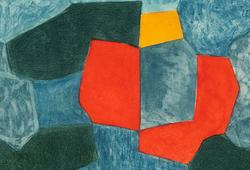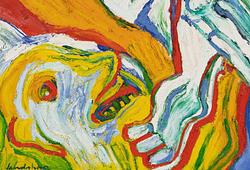Victor Vasarely
"SIMA"
Signed Vasarely. Also signed Vasarely on the reverse and marked. P. 1250. Canvas 120 x 120 cm. This work will be included in the forthcoming catalogue raisonné of the artist. We thank M. Pierre Vasarely for the authentication of this lot.
Alkuperä - Provenienssi
AH Grafik
Bohusgården, Uddevalla
Andreas Pajor Art Collection AB (purchased from above around 2000)
Private Collection, Sweden.
Muut tiedot
Victor Vasarely's artistic practice is today more relevant than ever. The visual effects he created by painting by hand in the mid-20th century anticipated the aesthetics of today's computer games and digital art. The strong colours, the undulating geometric compositions, as well as his high-contrast black-and-white paintings are experienced today as timeless.
Victor Vasarely, born in 1906 in Hungary, is considered one of the leading figures behind the Op Art movement with his innovative art focused on contrasting colours and optical illusions. Educated by László Moholy-Nagy, he came into contact with the works of Kandinsky, Gropius, Le Corbusier, and Mondrian, as well as the functionalism at the Bauhaus, which also made a strong impression on him. In 1930, Vasarely moved to Paris, where he successfully worked as a graphic designer and systematically explored the optical and emotional range of various graphic techniques. This led to an increased understanding of geometric form and its ability to evoke a sensory perception of space, matter, and energy. Vasarely developed his own form of geometric abstraction, which he varied infinitely, thereby creating different optical patterns with kinetic effects. He believed that colour and form were inseparable, and geometric forms were arranged in fluorescent colours in such a way that the eye perceived a fluctuating movement. Vasarely himself summarised this approach with the words: "Every form is the basis for a colour, every colour is an attribute of a form." In this way, forms from nature were transformed into purely abstract elements in his paintings.
"SIMA" is one of a number of paintings the artist created where an ordered grid seemingly swells and pushes out beyond the picture plane. Warm red connects the cells and contrasts with cool green, purple, and blue squares that gradually become smaller towards the edges of the canvas, as if retreating back into space.



















































